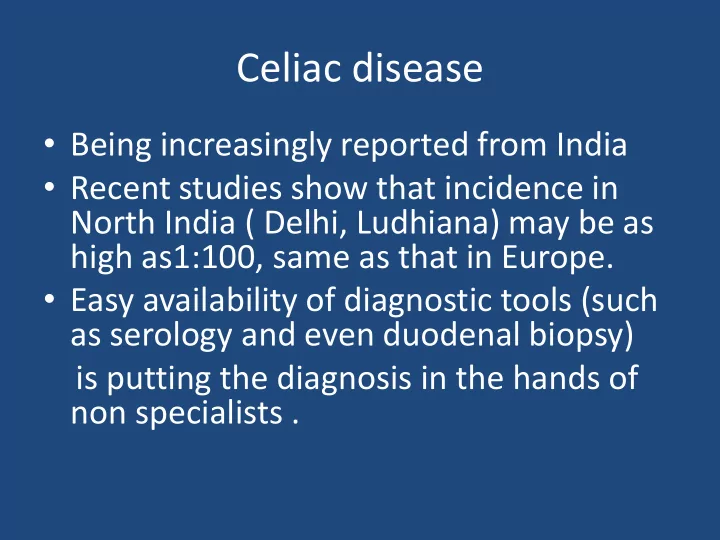

Celiac disease • Being increasingly reported from India • Recent studies show that incidence in North India ( Delhi, Ludhiana) may be as high as1:100, same as that in Europe. • Easy availability of diagnostic tools (such as serology and even duodenal biopsy) is putting the diagnosis in the hands of non specialists .
Diagnosis of Celiac Disease • Diagnosis remains a challenge • According to modified ESPGHAN criteria Clinical features of the disease Abnormal histology (as determined by Modified Marsh Criteria) on small bowel biopsy Clinical improvement on GFD Difficulties in applying these criteria in tropical countries
Clinical Features • In India and other tropical countries conditions like recurrent /chronic diarrhea, Malnutrition, failure to thrive, anemia, short stature (clinical features of CD) occur frequently and due to several other (more frequent )causes. • CD may often be asymptomatic • Diagnosis made on clinical features may be often misleading
Marsh in Tropical biopsies • Similarly in India and In other Tropical countries Villous atrophy is seen in conditions other than Celiac like tropical sprue, giardiasis, CMPI,PEM, bacterial overgrowth etc. Some studies suggest that even IEL counts in tropical settings may be higher (upto60/100EC) in non celiac biopsies. Difficult to interpret Marsh criteria specific to Celiac Disease. Over diagnosis of celiac disease possible if we depend , solely on Marsh Criteria
MARSH CRITERIA IN TROPICAL SETTINGS, HOW RELEVANT? Mukesh Yadav, Santosh K. Mittal Ranjana Gondal Chacha Nehru Bal Chikitsalaya and GB Pant Hospital New Delhi, India
MATERIAL & METHODS • Site- Chacha Nehru Bal Chikitsalya, Delhi ,India, A Tertiary level Teaching Hospital • Prospective case control study • Inclusion criteria Children 1-12 years of age on gluten containing diet. Clinical features (Chronic diarrhea, FTT , Short stature etc) suggestive of celiac disease • Exclusion criteria Children already diagnosed as Celiac or on gluten free diets. • Controls Children who were undergoing UGIE for diseases other than Celiac disease (portal hypertension, abdominal pain ,foreign body etc) . Approval of Institutional Ethic Committee was available
Material And Methods Apart from routine investigations serum anti TTGA levels were done in all cases utilizing kit supplied by EROIMMUN medizinische labrodiagnositika AG. Anti TTGA level of 20 IU/dl was taken as cut off point as recommened by the manufacturer Serum IgA levels were also obtained in those children with clinical features of Celiac disease but with normal anti TTGA.
Materials and Methods • On the basis of Clinical features and Anti TTGA levels, the Children were divided into 3 groups • Group I (42 children) Suggestive Clinical features and Serum Anti TTG A levels>20 IU/dl • Group II (32 Children) Suggestive Clinical features and Serum Anti TTGA levels <20 IU /dl • Group III (37 Children) Clinical features not suggestive of Celiac disease and also anti TTGA levels <20 IU/dl
Material and Methods After informed consent ,an Upper GI endoscopy was done and multiple (at least two)Duodenal biopsies were obtained from 2 nd or 3 rd part of Duodenum Biopsies were reported by a Pathologist who was blind to the Clinical features as well as to the serum anti TTGA levels The biopsies were interpreted as per Modified Marsh criteria
Modified Marsh Classification of Celiac Disease Marsh Type Intraepithelial Crypts Villi Lymphocytes/100 Enterocytes 0 <40 Normal Normal 1 >40 Normal Normal 2 >40 Increased Normal 3a >40 Increased Mild Atrophy 3b >40 Increased Marked Atrophy 3c >40 Increased Absent Type 0: Normal mucosa: CD highly unlikely Type 1 (Infiltrative lesion): Seen in patients on a gluten-free diet (suggesting minimal amounts of gliadin are being ingested); patients with DH; and family members of patients with CD. However, these patients need to be followed because they may convert to a Type 3 lesion. Type 2 (Hyperplastic type): Very rare; seen occasionally in DH Type 3 (Destructive lesion): Spectrum of changes seen in symptomatic CD
Modified Marsh Grading in different groups MODIFIED MARSH GROUP 1(CLINICAL GROUP 2(CLINICAL GROUP 3 GRADING FEATURES AND FEATURES AND ANTI TTGA ANTI TTGA >20IU/dL) <20IU/dL 0 5 22 30 1 2 3 4 2 0 0 0 3a 7 5 2 3b 14 0 1 3c 14 2 0 total 42 32 37
Results • IN GROUP 1 5/42(11.9%)-NORMAL HISTOLOGY ?False Negative Marsh • IN GROUP 2 10/32(31.2%)-ABNORMAL HISTOLOGY ?False Positive Marsh in symptomatic children • IN GROUP 3 7/37(18.9%)-ABNORMAL HISTOLOGY ?False Positive Marsh in asymptomatic children
EVALUATION OF MARSH CRITERIA AGAINST SEROPOSITIVITY Modified marsh Modified marsh total grade 2-3 grade 0-1 35 7(16.6%) 42 Serum ttgA>20IU/dl 10(14.5%) 59 69 Serum ttgA<20IU/dl 45 66 111 total
Levels of Anti TTGA & Marsh grading in group 1 Serum ttgA >100 Serum ttgA (20-100 Modified marsh IU/dl IU/dl) grades 4(11.76%) 1(12.5%) 0 1(2.94%) 1(12.50%) 1 0 0 2 29(84.29%) 6(75%) Not significant 3a -3c 34(100%) 8(100%) total
CONCLUSIONS • Histology May be Negative even in Clinically suspected and serologically positive Children • Histology may be positive (even Gr 3a-c) in apparently normal children or in sero negative, Clinically suspected children • Neither Serology ,Nor Histology can be taken in isolation for diagnosis of Celiac in Tropical settings
Recommendation • In view of High false positivity rates of modified marsh criteria in Tropical countries and Life long implication of diagnosis of CD ,it should be diagnosed only when both serology and histology are abnormal in a clinically suspected child.
Recommend
More recommend